
Lets summarise it all in a few quick sentences first…
The Jekyll is back. It is a single pivot design and has a pull shock designed by Cannondale AND Fox called the DYAD RT2. The shock is a dual shock with two independently tweakable damping circuits so you can tune the shock specifically for climbing AND DH. You can think of it as two shocks with some shared resources like a single air chamber. It comes with what Cannondale have called Attitude Adjust, which means in ‘Flow’ mode you not only get a full 150mm of travel at the back but the shock sags and the angles of the bike slacken and the BB lowers by up to half an inch from the 13.8 inches in Elevate mode. In ‘Elevate’ mode the shock sits where it is (the sag is reduced by 40% technically) and the rear provides a more climbing friendly 90 mm of travel. That’s the simplistic view. It’s quite clever and later we’ll have a look at the insides. But for now, lets get some pictures served.


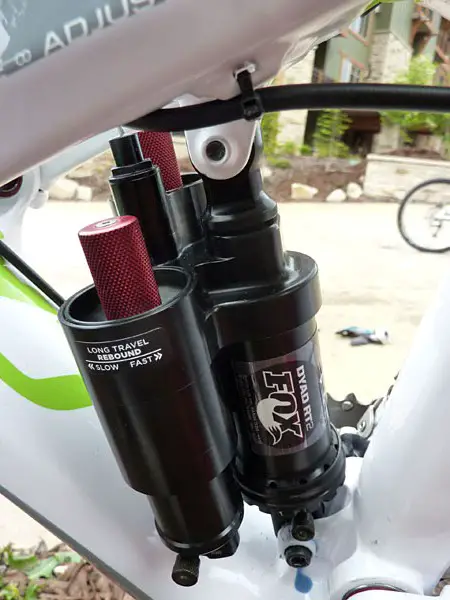

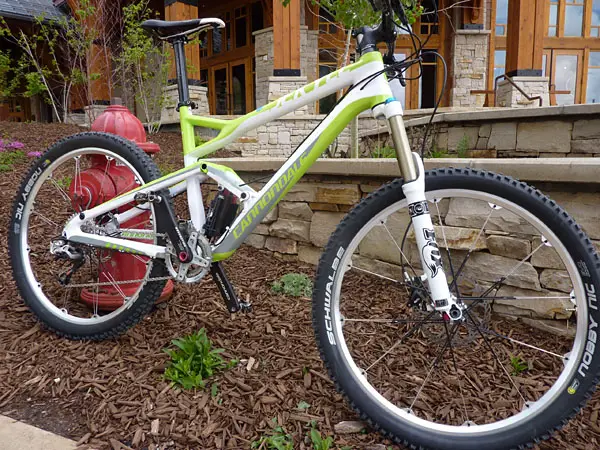
Over the Mountain?
Cannondale are claiming that whereas previous attempts at making All Mountain (good for climbing and descending) bikes have always been a compromise, their new shock design effectively gives the rider two independently tunable shocks for climbing and descending that can be selected at the push of a remote lever on the bars. No compromises this time say Cannondale – so much so that they’ve invented another genre for this bike..
We present to you the first ‘Over Mountain’ bike.
Yes! Really!
Jekyll Ride
Of course we didn’t just spend three days looking at bikes. We got to ride them too. First impressions are that it’s a short bike. Lots of journos were sizing up. I like short bikes so my 5’6″ temple like physique was just fine on a medium. The first thing everyone does is flick that remote shock control and see what happens. Now there’s some obvious comparisons to be made with Scott’s Genius shock but the main difference is how the bike slackens noticeably as you go from ‘Elevate’ mode to ‘Flow’ mode. The geometry really does change by a couple of degrees as that rear shock sits back into it’s sag (68.8 head angle in Elevate mode). We were warned that if it was set up right then in flow mode it would climb badly. This is not a bad thing – it fits with the no compromise aim of building a bike that can climb and descend really well. I can confirm that in Flow mode this bike climbs like a pig. It’s awful! This is a good start! Even on the flat Flow mode was just too wallowy. Flicked into ‘Elevate’ mode and the bike sits up and the rear shock settles into the settings you dialled in to the Elevate damping control. The wallowy bouncing vanishes and the bike feels like a comfortable XC bike. Descending is a lot of fun in Flow mode. The slack angles and the shortness of the bike really let you throw it into the corners and the confidence and control are akin to a much bigger bike.
Overall: Cannondale have taken a risk by doing their own thing with the rear shock, but what they have produced is a bike that certainly lessens the compromises inherent in the majority of bikes that try to be all things to all hills. How the shock stands up to long term abuse we will have to get back to you on.
We rode the carbon version but there will be aluminium versions at the entry price point level. As soon as we have UK prices we’ll report them. There will also be a bigger 180mm travel version of the Jekyll called the Claymore – after the bloody great Scottish sword. And also a women’s specific version called the Scarlet.. Although the ladies don’t get the carbon versions. Just plain old aluminium for you girls.. Sorry.
Scalpel

The Scalpel has had the fat trimmed for 2011. The Lefty fork is shortened to just 100mm (from 110mm) and is now constructed in a way that reduces the number of separate parts that need to be bonded together. The result is a lighter ‘fork’ that is stiffer and even the stem gets a sleek redesign with no top cap. The lefty also now comes with a hydraulic lockout switch and the lockout blow-off point is internally adjustable. The frame is a total redesign with continuous carbon fibres in the flexy chain stays (with another reduction in travel at the back from 100mm to 80mm) and a new bridge across the seat stays. The carbon is layered in the stays to provide maximum flex vertically with maximum stiffness laterally. The whole bike we rode in Park City, Utah weighed in at just under 19lbs! There’s just four Scalpel models – all carbon and they start at 3000 Euros! We’ll have UK prices when they are set. This is definitely a high end XC racers bike only.

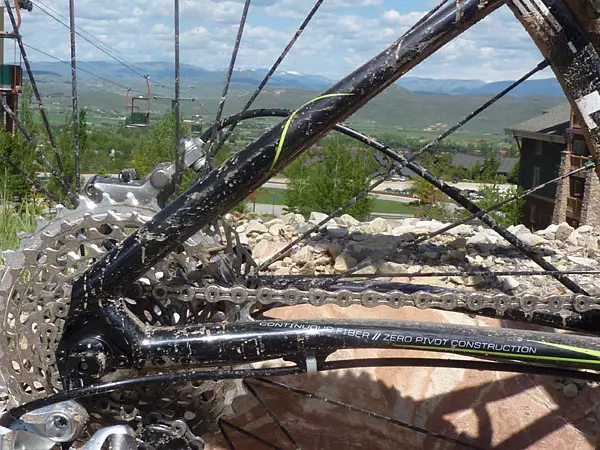
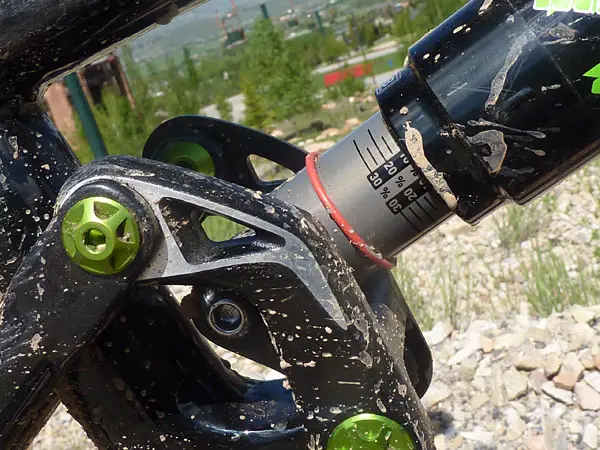
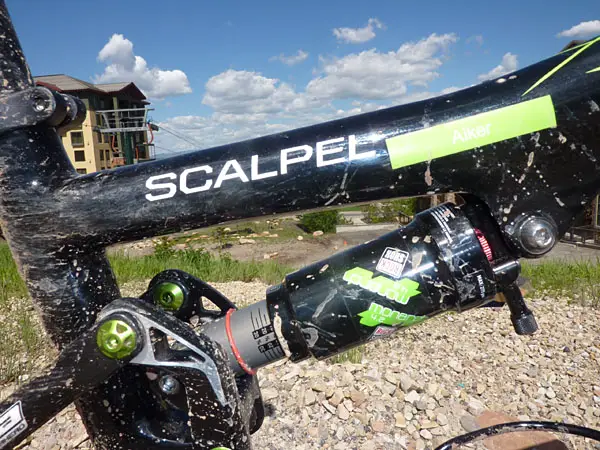

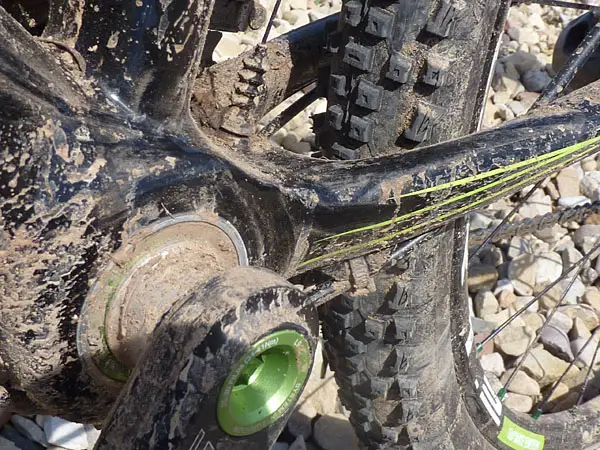
The Ride
On day one we had been given the Jekylls to ride on the mountain next to Canyons resort, Park City. The 2500 feet of climbing certainly allowed us to get used to the way the Jekyll climbed and the huge swoopy, steep descent let us really push the ‘Flow’ mode handling to our own limits at least if not the bike’s. The following day we were given Scalpels and sent on the very same loop. The climbing part was made a lot easier since we were only pushing a sub 19lb bike up the hill this time and it was easy to understand why the Lefty had been shortened to 100mm as at this weight for a whole bike a bit of power on a step up had the front end lifting off the ground pretty easily. The rear felt like a hardtail. It was noticeably stiff and yet looking down at the shock it was clear to see that the suspension was working smoothly and using plenty of it’s travel despite relying solely on the vertical flex of the stays.
At the top of the mountain (that was 8500 feet!) we were guided towards the start of the same DH trail we had used for the Jekylls the day before. This scared me. The bars on this bike are flat and super narrow. 90mm of travel didn’t sound like anywhere near enough. And it wasn’t! Scary? Oh yes! Clearly this bike is not meant to be thrown down mountains.
Overall: It’s starting price in the range of 3000 Euros tells you that this is a bike designed for hardcore, serious XC racers. It isn’t designed for comfort. That suspension at the back isn’t to ease the stresses on your spine – it’s function is purely to allow you to ride faster and grip more.
Video
Mike Cotty (UK Cannondale Sales Manager) Talks us briefly through the new Jekyll.
[stvideo src=”2010/06/cannondale2011.m4v”]
DYAD RT2 Fox Shock
Features of the new shock include a single air valve that fills both of the separate air chambers. You can see form these two diagrams that the ‘Elevate’ air chamber is smaller, which gives a steeper spring rate – better for climbing. Not great a big hits. The ‘Flow’ air chamber is much larger which gives a softer spring rate – Great for descending and big hits. Awful for climbing.







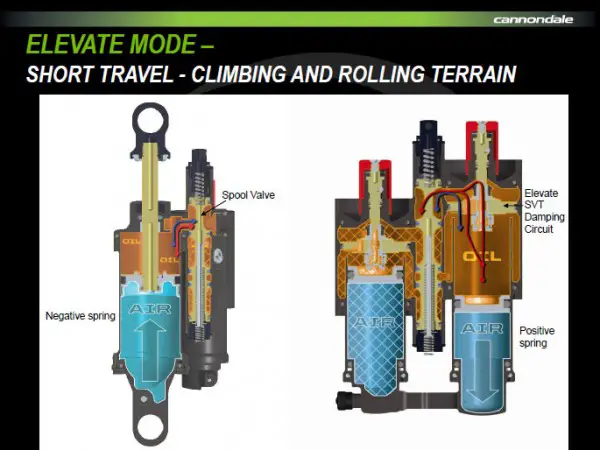
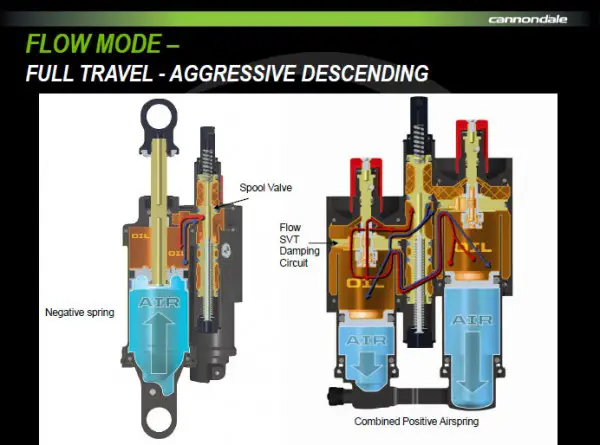








































I have a Scott Genius which has 3 modes of travel the third being complete lockout which is handy for the odd road i travel.
the 2 independant cycliders as apossed to one on the genius is just a way to get round the patent protection that Scott have on their shock.
This bike should be good as it’s by the same designer as the genius. But it comes with a higher price tag, bottom range genius is about £1800, bottom range jekell £2600.
I know which i would buy.